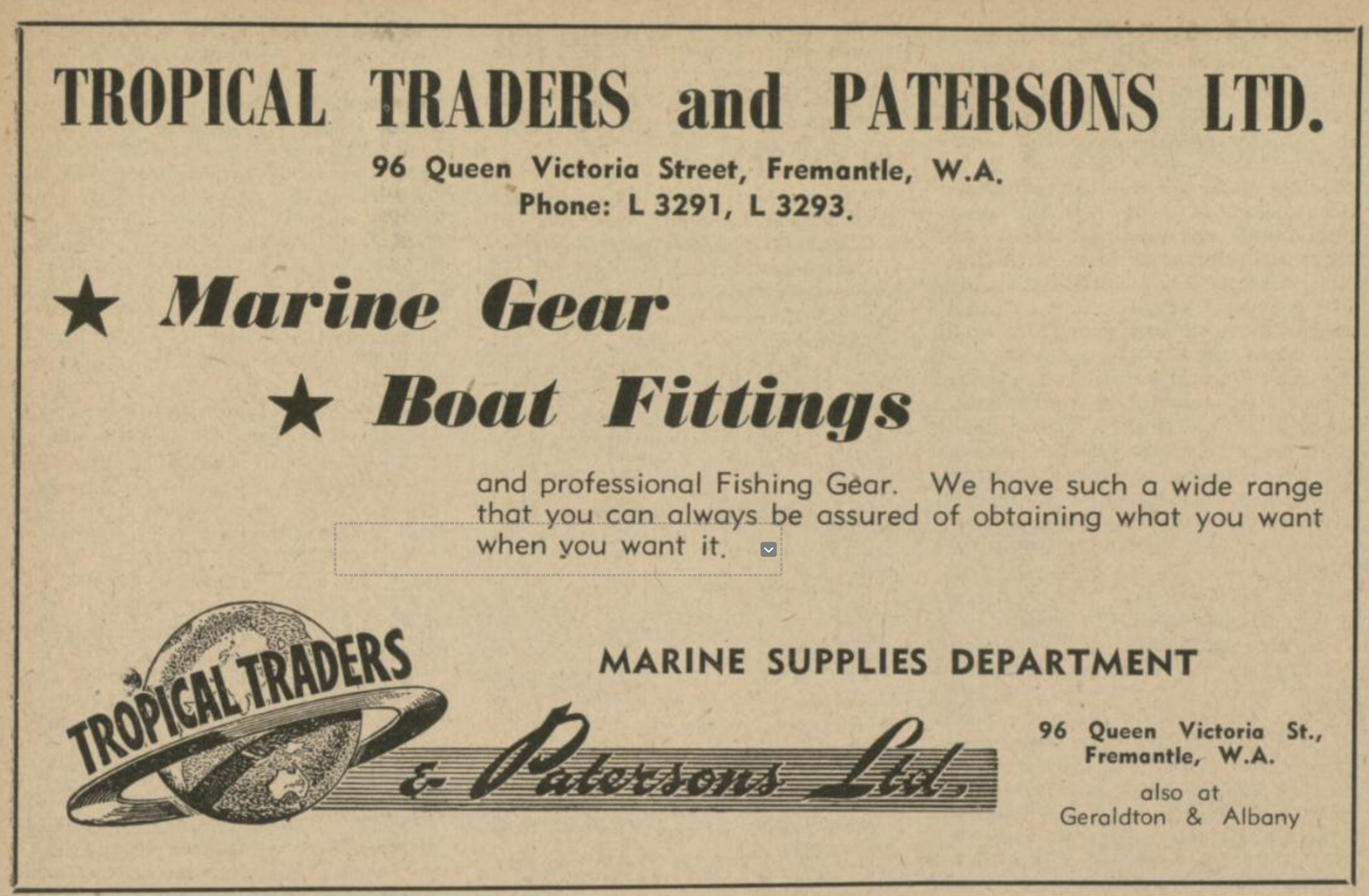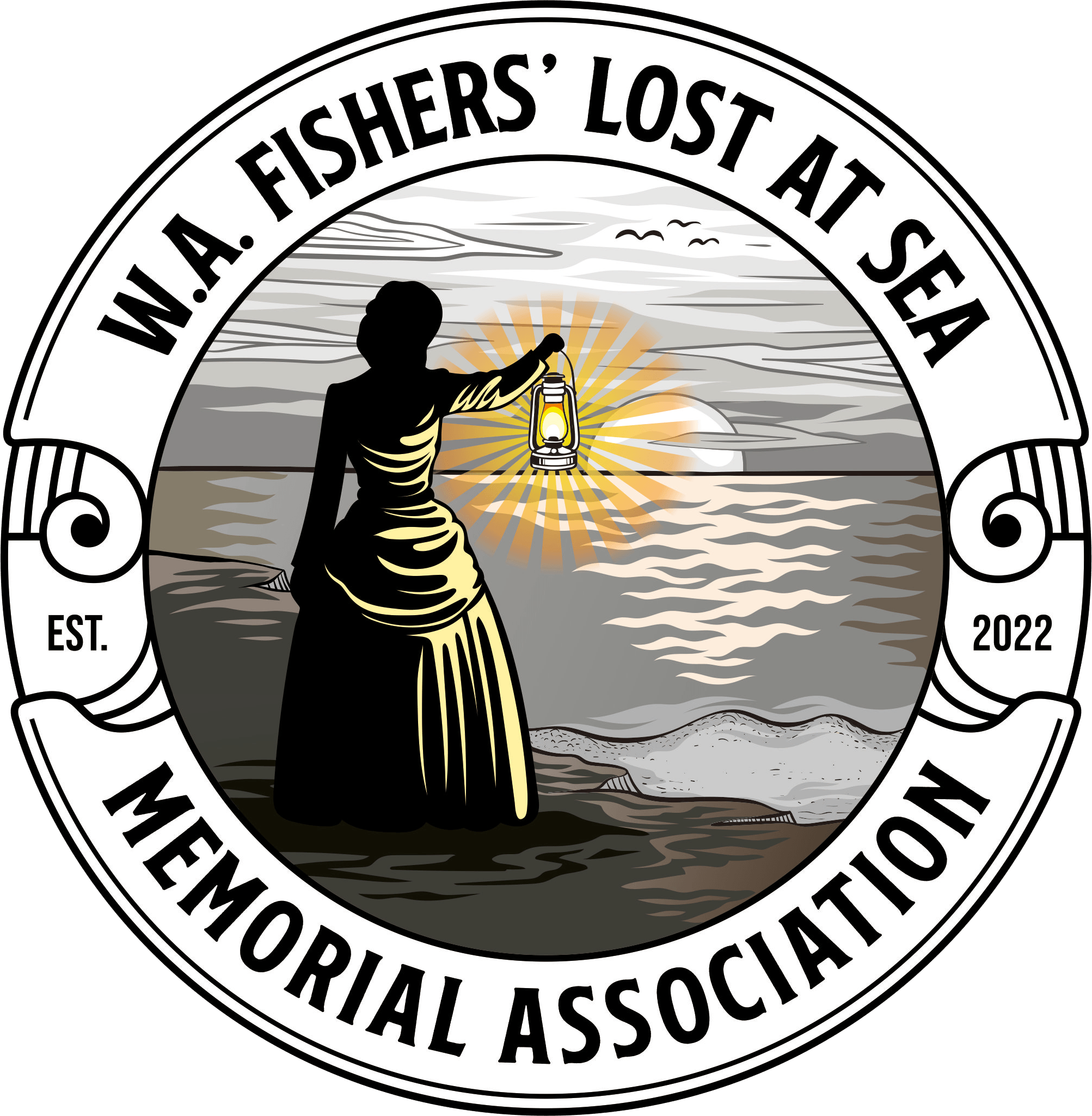Gauja
Vessel Name: Gauja
Karlis Dambitis
Drowned at Sea; Body never recovered
29 November 1967

Gauja was upturned and the survivors lashed themselves to the hull

Tropical Traders were heavily invested into the commercial fishing industry
The Gauja River is a large river in the Vidzeme region of Latvia. It is the only river of Latvia that begins and ends its flow in Latvia.
At 5:30am on the 29 November 1967, the fishing boat Gauja (LFBF 114), skippered by owner Karlis “Charlie” Dambitis, 54 years of age departed Fremantle for Cervantes. The Gauja was a new vessel on its maiden trip. It was 32 feet in length, constructed of bondwood, and fitted with a 135 Horsepower Volvo Penta diesel motor.
On board that day were two other persons;
Peter Mazalevskis, Crew member, 33 years of age, married, of 69 Central Avenue, Redcliffe.
Tamara Lebedevs, Passenger, 16 years of age, student, of 83 Central Avenue in Redcliffe.
These three persons shared a much deeper and common origin; All three were of Latvian ethnicity, and all three had sought the refuge of Australia as part of Group Resettlement efforts of the International Refugee Organisation (IRO) being either World War II Refugees or Displaced Persons. The IRO brought about 164,000 Displaced Persons from Germany to Australia between 1947 and 1951.
Leonidis Lebedevs and Irene Vitols arrived in Fremantle on 21 May 1949, on the SS Mozaffari. They would go on to give birth to Tamara Lebedevs not long after their arrival. The Mazalevskis family had arrived on 22 June 1949, onboard the ship Goya. Peter (Peteris) Mazalevskis was 14 years of age and accompanied his parents and siblings. Karlis Dambitis arrived in Fremantle on the 3 August 1949, on the SS Castel Bianco.
Dambitis was boarding at 65 Roberts Street in Bayswater. When in Cervantes, he resided in a shack made of asbestos and iron measuring 18 feet by 9 feet. At Roberts Street he had stored 150 cray pots and his Ford Utility. For their trip that day they carried anchor chains, ropes and stores, but no surplus gear or pots, as some of these had already been carted to Cervantes by truck.
Mazalevskis intended to join Dambitis for the crayfishing season. Mazalevskis had never fished at Cervantes, but regarded Dambitis as a competent Skipper. He had known him for three months. Lebedevs was on holidays and planning to join her uncle Magnus Vitols in Cervantes to work at the Tropical Traders Processing Factory.
At 5:45pm that same evening, they were rounding Cervantes Island about two miles away from the anchorage, south-west of the Island. They were intending to reach the anchorage by travelling through what is known as the South Passage.
As the Gauja turned Eastward toward the anchorage, it was struck by a large wave side on, but it righted itself. They saw a second big wave coming and tried to get the boat stern against it, but they didn’t have time to get set and the wave came over the stern and side and in about two seconds, the boat was upside down. At the time Mazalevskis and Lebedevs were in the cabin at the first helm watching the echo sounder for depth, which was showing 6 to 8 fathoms, while Dambitis was at the second helm fitted outside the cabin.
Lebedevs got out first, but Mazalevskis was initially trapped because the ropes floated around in the cabin and blocked the exit. Mazalevskis dived down and out of the cabin, by which time Lebedevs had climbed onto the keel and helped Mazalevskis up. They both managed to tie themselves to the boat’s upturned hull with rope.
Dambitis was last seen by the two survivors floating face down, in rough water about 30 to 40 yards from the boat about 10 minutes after the boat overturned. Dambitis was wearing blue jeans, a brown shirt, and brown desert boots.
There was a one-knot northerly current running at the time of his disappearance.
The body was floating out to sea and sharks were circling the area. A short time after capsizing, a shark got to within two feet of the survivors and Mazalevskis attempted to stab it with a knife. The sea was rough and they were unable to secure the body, or the boat’s dinghy, which they also saw drifting past them. Later the dinghy was recovered by John Seclari, a fisherman about seven miles West of Jurien Bay.
Both survivors drifted on the hull. During this time they had propped up the plywood top of the Wheelhouse against the keel and tied it to the propeller shaft, acting as a wind break and to attract attention.
At about 7:45am on 1 December, Stanley Brinkhuizen (29) and his crewman, Hughie Hastings were heading out West from Jurien Bay to go crayfishing. When entering the channel between Long Point and Long Island at the Southern tip of Jurien Bay, they saw an overturned hull. The hull was on a reef about 1.5 miles South West of Long Point and about 0.25 miles from Long Island. It was near what is called “Lighthouse” Island.
There they saw two exhausted people on the upturned hull. Mazalevskis and Lebedevs were rescued at about 8am, some 16 miles north of the scene of the accident. They had been in the water for 38 hours.
They had drifted out to sea and back several times during this period and covered many miles. Hastings called into the Jurien Bay Station at 8:20am that same day to report the incident.
The two survivors were now resting at Brinkhuizen’s home. Relatives of the rescued persons were notified by District Inspector C. H. Brown. He later prepared forms for the National Safety Council of WA (Water Safety Division), as well as the Department of the Navy. The Harbour and Lights Department, and Fisheries Department were also provided copies of the report.
Police Constable William Jolley initially investigated and reported on the tragedy. The Police search was delayed by a day due to unsuitable weather. The search teams included various fishing boats, fishing companies including the Fremantle Fishermen’s Co-operative Society, Ross Fisheries Ltd and Tropical Traders, Fisheries on patrol by land via four wheel drive vehicles and Police, assisted by the Press, TV and Radio Stations, who afforded maximum assistance without cost, by using their helicopters and aeroplanes at the scene on the day of the initial report.
Five days after the sinking, information was received that some wreckage had been sighted three miles out to sea at Snag Island, some 60 miles north of the scene of the accident. This significantly widened the search area and Inspector Brown made enquiries with Dr. Pearson as to the period which would elapse before a body, drowned in deep, cool salt water, would float and was advised about ten days.
Inspector Brown had news items put in the West Australian on the 15 December and Sunday Times on 17 December appealing to the public and holiday makers to report anything found on the beaches.
Wreckage and ropes were later identified from the Gauja at Wedge Island, some 30 miles south of Cervantes. The distance over which wreckage was located from Wedge Island to Snag Island was about 60 miles. This was attributed to the “North Current” flowing between one and three knots, approximately eight miles off the coast.
The hull of the Gauja was salvaged on 3 December by Stanley Brinkhuizen, at the request of Constable Jolley. It had drifted off the reef and was partially beached on Long Island. The hull was then pumped out and beached on a jinker ready for inspection by the insurance company and the owners. It was taken over by Insurers and agents of Tropical Traders, Lloyds of London.
The vessel was insured for $10,000, although the actual value was about $14,000. The hull was in fair condition at the time of salvage. The entire superstructure level to the gunwale was sheared off, apparently from drifting upside down over numerous reefs. The boat was eventually repaired and used again.
Tropical Traders operated from 96 Queen Victoria Street in Fremantle. They had a Bill of Sale for the fishing boat, more than 117 cray-pots in their possession and other fishing gear. The Manager of their branch in Cervantes, Magnus Vitols acted as a caretaker of the property he left behind, and was described as a close friend and fellow countryman of Dambitis.
The shack in Cervantes was later occupied by Walley Thompson.
Dambitis was of Latvian nationality from Madona, 170 kilometres east of Riga. He arrived in Western Australia in 1949, under papers issued by the German Military Government for displaced persons, and became a Naturalised Australian in 1961. He had been fishing at Cervantes for the past four seasons. During this time it appears he had never used the South Passage, but had operated in the Northern area.
The South Passage is entered by lining up the tip of the Northern end of Cervantes Island with a saddleback sandhill and approaching the anchorage on that line.
There are two islands, and it appears very likely that Dambitis lined up the wrong island, and travelled over a reef on the Southern side. This particular section of water can be unpredictable and waves can appear and break without warning, even on a still day.
On the day in question there was a rough sea with a strong South Easterly wind.
Dambitis left behind a son, Martin Karlis Dambitis in Latvia. He had no known relatives in Australia.
The Public Trustee was not prepared to accept property of the Estate until Dambitis was pronounced officially dead. Owing to the bulk of the property and its distribution it had been impracticable for the Police to take physical possession. Little could be done about the property until a family member made application to have Dambitis declared dead.
